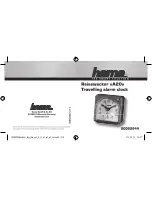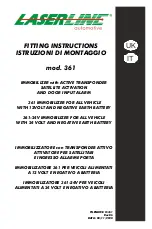
User Manual
205 DC Smoke Alarm
Complies with EN 14604:2005/AC:2008, VdS 3131:2010
Cautions
PRODUCT LIMITATIONS:
Caution! This device does not detect heat, gas or flame,
and should not be covered with a guard or similar obstructing item.
This device may not alert people who are hearing impaired. It is strongly recommended that
the special-purpose smoke alarms using visual or vibrating alerting devices, should be installed
for these occupants.
This device may not be effective in fires where smoke is prevented from reaching the device
(eg where intermediate doors are closed), where the fire grows so rapidly that the egress path
is blocked (even when correctly located), and where the fire is intimate to a person (eg where a
victim's clothes catch fire).
SLEEPING OCCUPANTS:
Studies have shown that smoke alarms may not awaken
all sleeping occupants. It is the responsibility of individuals in the household that are
capable of assisting others to provide assistance to those who may not be awakened by the
alarm sound, or to those who may be incapable of safely evacuating the area unassisted.
INSTALLATION LIMITATIONS:
This product is designed for use in a single
residential unit, such as a family home or apartment. Smoke alarms located outside
the dwelling may not provide adequate warning to occupants. This product is not
designed for use in non-residential buildings. Non-residential buildings require special fire
detection and alarm systems. This product alone is not a suitable substitute for a fire detection
system installed in places of work or where people sleep on a temporary basis, such as hotels
or motels, dormitories, hospitals, nursing homes or group homes of any kind, even if they were
once dwellings. Please refer to local regulations for fire detection and alarm system
requirements.
Features
Numens 205 DC smoke alarms provide battery powered smoke detection,
together with alarm functions within a single unit. The technology provides early
detection of fire and high immunity against unwanted alarms.
Numens 205 DC smoke alarms are powered by a long-life lithium-ion battery,
and do not require a mains supply. Models are available with either
user-replaceable batteries or non-replaceable batteries.
Interconnectable 205 DC smoke alarms use a wireless transmission path.
Configuration into a closed group ensures that other units within radio signal
range are not affected by a test or fire alarm occurring within the configured
group.
Numens 205 DC smoke alarms are suitable for general residential applications,
and provides home owners and installers with an easy-to-install, long-life
solution for life safety and property protection applications.
Normal Operation
When operating normally, a red LED adjacent to the Test/Hush button will flash
every 40 s.
Alarm Condition
When smoke is detected, an internal sounder will activate to alert occupants,
and the red LED will flash every 1 s. The sounder is a loud, pulsating alarm.
Fault Conditions
Battery Low
When the battery is depleted, the smoke alarm will emit a short audible signal
every 40 s, synchronized with a single flash of the red LED indicator. The
Battery Low indication will operate for at least 30 days.
Models 205-001 and 205-004
The battery for Models 205-001 and 205-004 is not user-replaceable and will
last up to 10 years under normal conditions. When the Low Battery signal is
given, replace the smoke alarm without delay.
Models 205-002 and 205-005
The battery for Models 205-002 and 205-005 (wireless interconnection) is
replaceable by the user and will last up to 5 years under normal conditions.
When the Low Battery signal is given, replace the battery without delay.
Models 205-003 and 205-006
The battery for Models 205-003 and 205-006 is replaceable by the user and will
last up to 10 years under normal conditions. When the Low Battery signal is
given, replace the battery without delay.
Smoke Chamber Fault
When a fault is detected in the smoke sensing chamber, the smoke alarm will
emit a short audible signal every 40 s sounder, and a single flash of the red
LED indicator midway between the audible indications.
Test/Hush Button
Test
When in the Normal condition, pressing and holding the Test/Hush button for
5 s will activate the smoke alarm to check its operation. The alarm will sound,
and the red LED will flash every 1 s. Releasing the Test/Hush button will cancel
the alarm test.
For interconnected smoke alarms (Models 205-002 and 205-005), a test on one
unit will operate all interconnected units. After releasing the Test/Hush button, it
may take up to 10 s for the interconnected units to silence.
Hush (Alarm Condition)
When in the Alarm condition, pressing the Test/Hush button reduces the
sensitivity of the smoke alarm for 9 min and silences the alarm sounder. The
hush feature allows time for the smoke to dissipate. During the hush time, the
red LED will continue to flash every 1 s on the unit in fire alarm, and every 6 s
on any interconnected units.
The hush feature should only be used after the cause of the alarm is
known (such as an unwanted alarm from cooking fumes).
After the hush time has expired, the smoke alarm will automatically return to
normal sensitivity. If smoke is still present in the unit, the alarm sounder will re-
activate. The hush feature can be used repeatedly.
Hush (Battery Low)
When the smoke alarm signals that the battery is depleted, pressing the
Test/Hush button silences the audible signal for 10 hours. During the hush time,
the red LED will flash every 20 s.
After the hush time has expired, the smoke alarm will automatically return to
normal. If the battery has not been changed (excluding Models 205-001 and
205-004), the low battery signal will re-activate. The hush feature can be used
repeatedly.
Hush (Smoke Chamber Fault Condition)
When the smoke alarm signals a smoke chamber fault, pressing the Test/Hush
button silences the fault condition for 10 hours. During the hush time, the red
LED will flash every 20 s.
After the hush time has expired, the smoke alarm will automatically return to
normal. If the smoke chamber fault is still present, the fault signal will
re-activate. The hush feature can be used repeatedly.
Interconnection (where fitted)
Interconnectable smoke alarms (Models 205-002 and 205-005) use a wireless
transmission path to connect units together.
Individual units must first be configured into a closed Group so that
sounders on all units in the group will activate during an Alarm condition,
Alarm Hush, or a Test.
When smoke is detected in one unit, the sounders in all interconnected units will
activate. The LED indicator on units that have not detected smoke will flash
every 6 s. This allows the home owner to quickly locate the cause of the alarm.
When a unit is tested, the sounders in all interconnected units will activate and
the LED indicator will flash every 40 s. After releasing the Test/Hush button, it
may take up to 10 s for the interconnected units to silence.
The maximum transmission path between each interconnected unit is 500 m.
There is no limit to the number of units that can be interconnected using the
wireless interconnection function.
WARNING
: Wireless interconnection signalling may not operate in the
low battery condition.
Understanding Indicator and Alarm Signals
205 DC smoke alarms produce the following indicator and alarm signals,
depending on the status condition.
Primary Smoke Alarm
LED
Audible Signal
Status Condition
Flash every 40 s
—
Normal
Flash every 1 s
0.5 s on / 0.5 s off
Fire alarm
Flash every 1 s
—
Hush after fire alarm
Flash every 1 s
0.5 s on / 0.5 s off
Test
Flash every 40 s
Short beep at the same
time of LED flash
Low battery
Flash every 20 s
—
Hush after low battery fault
Flash every 40 s
Short beep midway
between LED flashes
Smoke chamber fault
Flash every 20 s
—
Hush after smoke chamber fault
Interconnected Units
When configured as a group, interconnected units produce the following
additional indicator and alarm signal when the primary unit is operated.
LED
Audible Signal
Status Condition
Flash every 6 s
—
Hush after fire alarm, activated
from another device
Flash every 40 s
0.5 s on / 0.5 s off
Test activated from another
device






















